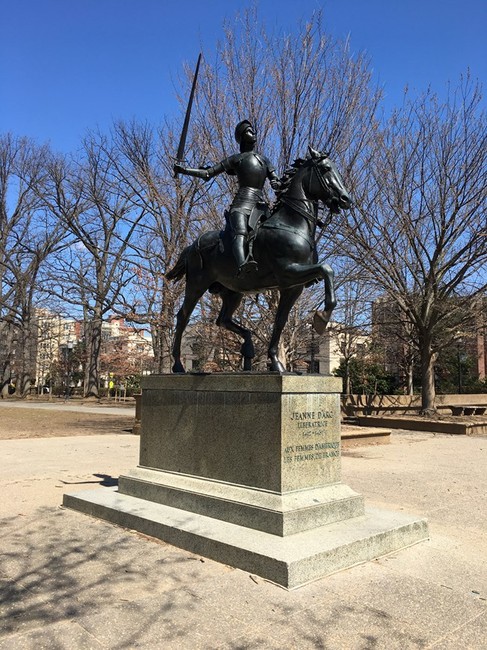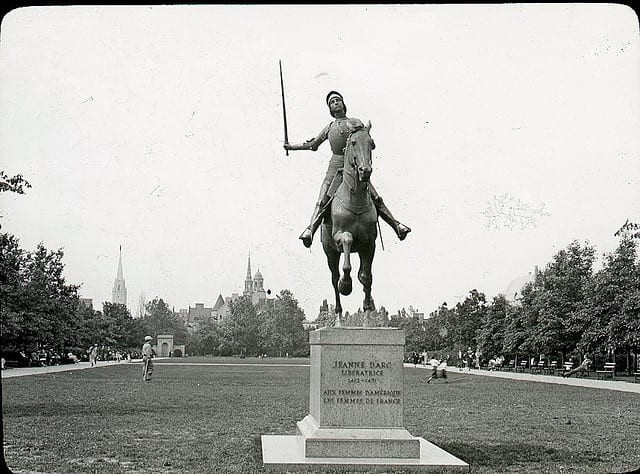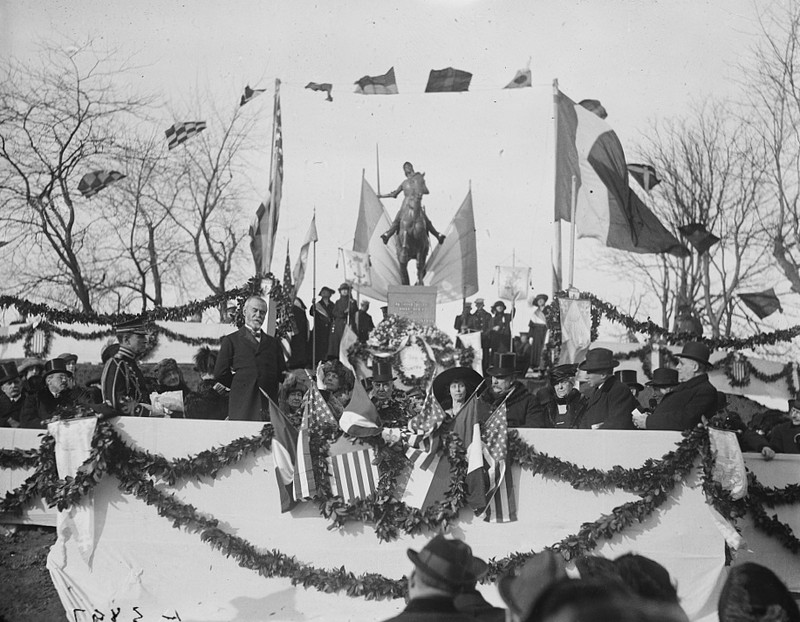Joan of Arc Statue
Introduction
Text-to-speech Audio
Images
Joan of Arc statue in March 2018

The statue in Meridian Hill Park c. 1922

A photograph from the dedication ceremony in 1922

Backstory and Context
Text-to-speech Audio
Joan of Arc (French: Jeanne d’Arc) was born in the small, rural village of Domrémy (now Domrémy-la-Pucelle) in northeastern France around 1412. From a peasant family, she never learned to read or write, but was deeply pious. At the age of thirteen, she began hearing divine voices and having visions of St. Michael the Archangel, St. Catherine of Alexandria, and St. Margaret of Antioch. They ordered her to drive the English out of France and see to it that the dauphin (Charles of Valois, the eldest son of deceased French king Charles VI) be crowned king of France.
At the time, France was embroiled in an intermittent conflict known as the Hundred Years’ War (1337-1453). By 1420, France's enemies had gained the upper hand. England and its French allies (such as the duke of Burgundy, Philip the Good) controlled much of the northern part of the country. Additionally, a peace treaty signed that year disinherited the dauphin, making Henry V not only the king of England, but also the king of France.
In 1428, Joan of Arc set out to fulfill her divinely-inspired mission. She met with the dauphin and, after weeks of interrogation at the hands of his theologians, he provided her with an army to break the siege at Orléans. Dressed in white armor and riding a white horse, she led several successful assaults against the Anglo-Burgundian forces and saved the city in May 1429. Over the course of the subsequent two months, she escorted the dauphin through enemy-held territory to Reims, where he was crowned king of France in July. The following year, in May 1430, Joan of Arc led her army to the town of Compiègne to defend it from a Burgundian assault. In the chaos of the fighting, she was unhorsed and failed to make it inside the town before the gates closed. Burgundian forces captured her and eventually turned her over to an ecclesiastical court in Rouen. For over a year, she was interrogated and tortured. After being tried and convicted of heresy, she was burned at the stake in May 1431.
After he succeeded in ousting the English from France in 1453, Charles VII ordered a new trial to clear Joan of Arc’s name. In 1456, Pope Calixtus II retried the case and judged her innocent. Five centuries later, in 1909, Pope Pius X beatified Joan of Arc in a ceremony at Notre Dame Cathedral in Paris. In 1920, Pope Benedict XV made her a saint.
Shortly after Joan of Arc’s canonization, Le Lyceum Société des Femmes de France à New York gifted a statue of the French national heroine to the women of America. Dedicated on January 6, 1922 during an elaborate ceremony, the bronze equestrian statue, which measures ten feet in length and nine feet in height, is an exact replica of the one designed by sculptor Paul Dubois in the late nineteenth century that stands in front of the Reims Cathedral. In attendance at the dedication ceremony was President Warren G. Harding, French Ambassador to the United States Jean Jules Jusserand, and Secretary of War John W. Weeks. Located in Meridian Hill Park, it is the only equestrian statue of a woman in the nation’s capital.
Since its unveiling in 1922, the statue has been repeatedly targeted by vandals. In 1978, Joan of Arc’s sword was stolen and not replaced until 2011. In September 2016, her sword was stolen again. Two years later, thanks to support from A&E Television Networks’ History and Lifetime, a new sword was installed.
Cite This Entry
Kennedy, Amelia and Francis Curran. "Joan of Arc Statue." Clio: Your Guide to History. December 29, 2020. Accessed March 22, 2025. https://theclio.com/tour/386/2
Sources
History.com Editors. "Joan of Arc." History. A&E Television Networks. 10 March 2020. Web. 7 December 2020 <https://www.history.com/topics/middle-ages/saint-joan-of-arc>.
"Joan of Arc Has a New Sword!" National Park Service. U.S. Department of the Interior. 10 May 2018. Web. 7 December 2020 <https://www.nps.gov/articles/joan-of-arc-sword.htm>.
"Joan of Arc Memorials." Monumental News 34, no. 5 (May 1922): 292-293.
Lawler, Jennifer. Encyclopedia of Women in the Middle Ages. Jefferson, NC: McFarland & Company, Inc., 2001.
Robin, Diana, Anne R. Larsen, and Carole Levin, eds. Encyclopedia of Women in the Renaissance: Italy, France, and England. Santa Barbara, CA: ABC-CLIO, 2007.
https://www.nps.gov/articles/joan-of-arc-sword.htm
https://ghostsofdc.org/2012/01/08/then-and-now-joan-of-arc-statue-in-meridian-hill-park/
https://en.wikipedia.org/wiki/Equestrian_statue_of_Joan_of_Arc_(Washington,_D.C.)

